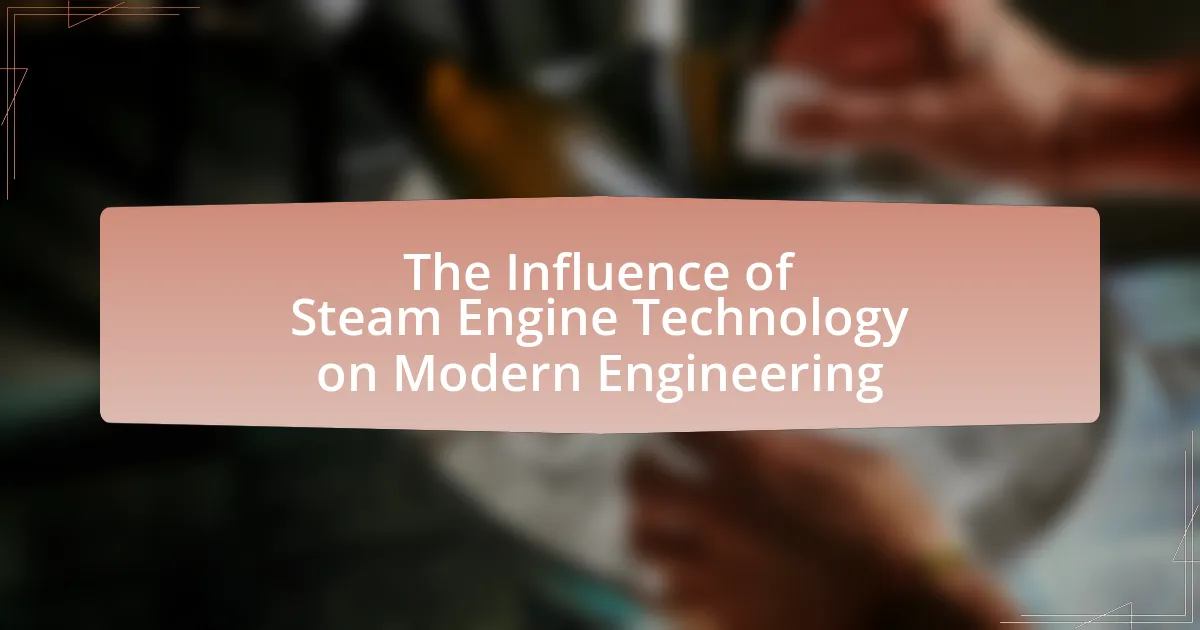The article examines the profound influence of steam engine technology on modern engineering, highlighting its foundational role in thermodynamics and mechanical engineering. It traces the origins and evolution of steam engines, detailing key innovations such as the separate condenser and high-pressure steam, which significantly enhanced efficiency. The discussion extends to the impact of steam engines during the Industrial Revolution, their contributions to manufacturing and transportation, and their relevance in contemporary engineering practices. Additionally, the article explores the environmental implications of steam technology, its potential for sustainability, and future trends in energy production, emphasizing the lessons engineers can draw from this historical technology.

What is the Influence of Steam Engine Technology on Modern Engineering?
The influence of steam engine technology on modern engineering is profound, as it laid the foundational principles for thermodynamics and mechanical engineering. The steam engine, developed in the 18th century, introduced concepts such as energy conversion and efficiency, which are critical in contemporary engineering practices. For instance, the laws of thermodynamics, which govern energy transfer and conversion, were significantly shaped by the operational principles of steam engines. Additionally, steam power facilitated the Industrial Revolution, leading to advancements in machinery design, manufacturing processes, and transportation systems. These historical developments have directly influenced modern engineering disciplines, including mechanical, civil, and aerospace engineering, by establishing standards for design, efficiency, and innovation.
How did steam engine technology originate and evolve?
Steam engine technology originated in the early 18th century, primarily through the work of Thomas Newcomen, who developed the first practical steam engine in 1712 for pumping water out of mines. This engine utilized atmospheric pressure to create a vacuum, allowing it to operate efficiently in mining applications. The technology evolved significantly with James Watt’s improvements in the late 18th century, where he introduced a separate condenser, which increased efficiency and allowed steam engines to be used in various industries, including textiles and transportation. By the 19th century, steam engines had become integral to the Industrial Revolution, powering locomotives and ships, which transformed global trade and mobility. The advancements in steam engine design and application laid the groundwork for modern engineering principles, influencing the development of internal combustion engines and other technologies.
What were the key innovations in steam engine design?
The key innovations in steam engine design include the development of the separate condenser, the use of high-pressure steam, and the introduction of the rotary motion mechanism. The separate condenser, invented by James Watt in 1765, significantly improved efficiency by allowing steam to condense without cooling the cylinder, thus reducing energy loss. The adoption of high-pressure steam enabled engines to produce more power from smaller boilers, enhancing performance and reducing fuel consumption. Additionally, the rotary motion mechanism, which converted linear motion into rotational motion, allowed steam engines to drive machinery directly, facilitating advancements in various industries. These innovations collectively transformed steam engines into powerful tools that laid the groundwork for the Industrial Revolution and modern engineering practices.
How did the Industrial Revolution impact steam engine development?
The Industrial Revolution significantly advanced steam engine development by driving innovations in efficiency and power. This period, spanning from the late 18th to the early 19th century, saw the introduction of key improvements, such as James Watt’s separate condenser in 1769, which increased the engine’s efficiency by reducing steam loss. Additionally, the demand for mechanized production and transportation during the Industrial Revolution led to the widespread adoption of steam engines in factories, locomotives, and ships, further propelling technological advancements. By 1800, steam engines had become integral to industrial processes, marking a pivotal shift in engineering practices and laying the groundwork for modern engineering principles.
What are the fundamental principles behind steam engine technology?
The fundamental principles behind steam engine technology are based on the conversion of thermal energy into mechanical work through the use of steam. Steam engines operate by heating water in a boiler to produce steam, which then expands and pushes a piston or turns a turbine, generating motion. This process relies on the principles of thermodynamics, particularly the conversion of heat energy into kinetic energy, as described by the first law of thermodynamics, which states that energy cannot be created or destroyed, only transformed.
Historically, steam engines were pivotal in the Industrial Revolution, enabling significant advancements in transportation and manufacturing. For instance, James Watt’s improvements in the late 18th century increased efficiency by introducing a separate condenser, which minimized heat loss and improved the engine’s overall performance. This innovation exemplifies how steam engine technology laid the groundwork for modern engineering practices, influencing the design of various machinery and power systems.
How does the thermodynamic cycle apply to steam engines?
The thermodynamic cycle applies to steam engines through the conversion of heat energy into mechanical work via a series of processes, primarily the Rankine cycle. In this cycle, water is heated to produce steam, which expands in a cylinder to perform work on a piston. The steam then condenses back into water, completing the cycle. This process is characterized by four main stages: heating, expansion, cooling, and condensation, which are essential for the efficient operation of steam engines. Historical data shows that steam engines, utilizing the Rankine cycle, were pivotal in the Industrial Revolution, enabling significant advancements in transportation and manufacturing.
What role do pressure and temperature play in steam engine efficiency?
Pressure and temperature are critical factors that directly influence the efficiency of steam engines. Higher pressure increases the energy available from steam, allowing for more work to be done during the expansion phase, which enhances overall efficiency. For instance, steam engines operating at higher pressures, such as 150 psi compared to 50 psi, can achieve greater thermal efficiency due to the increased temperature of the steam, which leads to a higher temperature differential between the steam and the cooling medium. This principle is supported by the Carnot efficiency equation, which states that efficiency is dependent on the temperature difference between the heat source and the heat sink. Therefore, optimizing both pressure and temperature is essential for maximizing the performance and efficiency of steam engines.
What are the major contributions of steam engine technology to modern engineering?
Steam engine technology significantly contributed to modern engineering by introducing principles of thermodynamics, enabling the development of efficient energy conversion systems. The steam engine’s ability to convert heat energy into mechanical work laid the groundwork for future innovations, such as internal combustion engines and electric power generation. Additionally, the steam engine facilitated advancements in manufacturing processes, transportation systems, and industrial machinery, which were pivotal during the Industrial Revolution. The widespread adoption of steam power led to increased productivity and the establishment of standardized engineering practices, influencing the design and operation of modern machines and infrastructure.
How has steam power influenced transportation engineering?
Steam power has significantly influenced transportation engineering by enabling the development of railways and steamships, which revolutionized the movement of goods and people. The introduction of steam locomotives in the early 19th century allowed for faster and more efficient land transport, exemplified by George Stephenson’s locomotive, the “Locomotion No. 1,” which began service in 1825. This innovation led to the expansion of railway networks, facilitating trade and economic growth. Additionally, steam-powered ships, such as the SS Great Western launched in 1837, transformed maritime transport by providing reliable and quicker sea travel compared to sailing vessels. The impact of steam power on transportation engineering is evident in the establishment of infrastructure that supports high-capacity, high-speed travel, fundamentally changing societal dynamics and commerce.
In what ways has steam technology impacted manufacturing processes?
Steam technology has significantly transformed manufacturing processes by enabling mechanization, increasing production efficiency, and facilitating the rise of factories. The introduction of steam engines allowed for the replacement of manual labor with powered machinery, which led to faster and more consistent production rates. For example, the textile industry saw a dramatic increase in output due to steam-powered looms, which could operate continuously and at higher speeds than human workers. Additionally, steam technology contributed to the centralization of production in factories, where multiple machines could be powered by a single steam engine, optimizing resource use and reducing costs. Historical data indicates that by the early 19th century, steam engines had become integral to industries such as textiles, iron, and coal mining, fundamentally altering the landscape of manufacturing and laying the groundwork for the Industrial Revolution.

How does steam engine technology relate to contemporary engineering practices?
Steam engine technology laid the foundational principles of thermodynamics and mechanical engineering that are integral to contemporary engineering practices. The steam engine’s development in the 18th century introduced concepts such as energy conversion, efficiency, and the use of heat to perform work, which are still relevant in modern engineering disciplines. For instance, the laws of thermodynamics, which were influenced by steam engine operation, govern the design of engines and power plants today. Additionally, steam engines prompted advancements in materials science and mechanical design, leading to innovations in various fields, including automotive and aerospace engineering. The historical significance of steam engines is evidenced by their role in the Industrial Revolution, which transformed manufacturing processes and established engineering as a critical discipline in society.
What modern technologies have evolved from steam engine principles?
Modern technologies that have evolved from steam engine principles include steam turbines, internal combustion engines, and various forms of power generation systems. Steam turbines, for instance, utilize the principles of steam expansion and pressure to convert thermal energy into mechanical energy, which is foundational in electricity generation in power plants. Internal combustion engines, while differing in operation, share the concept of converting thermal energy into mechanical work, a principle rooted in steam engine technology. Additionally, advancements in thermal management and heat exchangers in modern engineering owe their origins to the efficiency improvements sought in steam engines. These technologies demonstrate the lasting impact of steam engine principles on contemporary engineering practices.
How do steam turbines compare to traditional steam engines?
Steam turbines are more efficient and capable of generating higher power outputs compared to traditional steam engines. While traditional steam engines operate on a reciprocating mechanism, steam turbines utilize a rotary motion, allowing for smoother operation and reduced mechanical wear. This design enables steam turbines to achieve thermal efficiencies of around 40-50%, significantly higher than the 10-20% efficiency typical of traditional steam engines. Additionally, steam turbines can handle higher steam pressures and temperatures, which further enhances their efficiency and power generation capabilities.
What is the relevance of steam technology in renewable energy systems?
Steam technology is relevant in renewable energy systems primarily for its role in converting thermal energy into mechanical energy, which can then be used to generate electricity. This technology is utilized in concentrated solar power (CSP) systems, where mirrors focus sunlight to heat a fluid, producing steam that drives turbines. According to the U.S. Department of Energy, CSP systems can achieve efficiencies of up to 20% in converting solar energy into electricity, demonstrating the effectiveness of steam technology in harnessing renewable resources. Additionally, steam technology is integral to biomass energy systems, where organic materials are combusted to produce steam for electricity generation, further emphasizing its importance in diversifying renewable energy sources.
How do engineers apply lessons from steam engine technology today?
Engineers apply lessons from steam engine technology today by utilizing principles of thermodynamics and efficiency in modern energy systems. The steam engine’s development highlighted the importance of converting thermal energy into mechanical work, which informs the design of contemporary power plants and engines. For instance, combined cycle gas plants, which use both gas and steam turbines, achieve higher efficiency rates by maximizing energy conversion, a concept rooted in steam engine technology. Additionally, the steam engine’s emphasis on mechanical design and materials has influenced the engineering of modern machinery, ensuring durability and performance in various applications.
What best practices have emerged from steam engine engineering?
Best practices that have emerged from steam engine engineering include the principles of thermodynamics, efficient heat transfer, and the importance of materials selection. Thermodynamics, particularly the laws governing energy conversion, has shaped modern engineering practices by emphasizing efficiency in energy use. Efficient heat transfer techniques, developed through steam engine design, have influenced various applications, including HVAC systems and power generation. Additionally, the careful selection of materials to withstand high pressure and temperature, as seen in steam engines, has informed modern engineering standards for safety and durability in various industries. These practices are validated by historical advancements in steam technology, which laid the groundwork for contemporary engineering methodologies.
How can steam engine technology inform future engineering innovations?
Steam engine technology can inform future engineering innovations by providing foundational principles of thermodynamics, mechanical design, and energy conversion. The steam engine, developed in the 18th century, exemplifies the conversion of thermal energy into mechanical work, a concept that remains central in modern engineering applications such as power generation and propulsion systems. Historical advancements, such as James Watt’s improvements to steam engines, highlight the importance of efficiency and scalability, which are critical in contemporary engineering challenges. Furthermore, the steam engine’s role in the Industrial Revolution illustrates how innovative technologies can drive societal change, emphasizing the need for engineers to consider the broader implications of their designs.

What challenges and opportunities does steam engine technology present in modern engineering?
Steam engine technology presents both challenges and opportunities in modern engineering. The challenges include the inefficiency of steam engines compared to contemporary energy sources, as they typically operate at lower thermal efficiencies, often below 30%, which limits their practicality in high-performance applications. Additionally, the maintenance and operational costs associated with steam engines can be significant, particularly in terms of boiler safety and emissions control.
Conversely, opportunities arise from the historical significance and foundational principles of steam technology, which can inspire innovations in renewable energy systems, such as biomass and geothermal applications. Furthermore, steam engines can serve as educational tools in engineering curricula, illustrating fundamental concepts of thermodynamics and mechanical design. The revival of interest in steam technology for niche applications, such as heritage railways and sustainable energy projects, highlights its potential to contribute to modern engineering solutions while promoting historical preservation.
What are the environmental impacts of steam engine technology?
Steam engine technology has significant environmental impacts, primarily due to its reliance on fossil fuels, which contributes to air pollution and greenhouse gas emissions. The combustion of coal, wood, or oil in steam engines releases carbon dioxide, sulfur dioxide, and particulate matter into the atmosphere, leading to climate change and respiratory health issues. Historical data indicates that the widespread use of steam engines during the Industrial Revolution resulted in increased coal consumption, which is linked to a rise in atmospheric CO2 levels from approximately 280 parts per million in the pre-industrial era to over 400 parts per million today. Additionally, steam engines often required extensive water resources for operation, leading to water depletion and thermal pollution in nearby ecosystems.
How can steam engines be made more sustainable?
Steam engines can be made more sustainable by integrating renewable energy sources, such as biomass or solar power, to generate steam. This approach reduces reliance on fossil fuels, which are a significant source of greenhouse gas emissions. For instance, using biomass as a fuel source can lower carbon emissions by up to 90% compared to traditional coal-fired steam engines. Additionally, implementing advanced technologies like combined heat and power (CHP) systems can enhance efficiency by utilizing waste heat for additional energy production, further minimizing environmental impact.
What are the challenges in retrofitting steam technology for modern use?
Retrofitting steam technology for modern use presents several challenges, including efficiency limitations, compatibility with contemporary systems, and regulatory compliance. Efficiency limitations arise because traditional steam systems often operate at lower thermal efficiencies compared to modern alternatives, making them less viable for energy-intensive applications. Compatibility issues occur when integrating older steam technology with advanced digital controls and automation systems, which can lead to operational inefficiencies or increased maintenance costs. Additionally, regulatory compliance poses a challenge, as modern environmental standards may require significant modifications to existing steam systems to reduce emissions and improve safety, which can be costly and complex to implement.
What future trends can we expect in steam engine technology?
Future trends in steam engine technology include advancements in efficiency, integration with renewable energy sources, and the development of hybrid systems. These trends are driven by the need for sustainable energy solutions and improved performance metrics. For instance, modern steam engines are increasingly being designed to operate with lower emissions and higher thermal efficiency, often exceeding 40% efficiency in some applications. Additionally, the integration of steam technology with solar thermal energy systems is gaining traction, allowing for more versatile energy generation. Research indicates that hybrid systems combining steam engines with electric propulsion can enhance overall system efficiency and reduce reliance on fossil fuels, aligning with global sustainability goals.
How might advancements in materials science affect steam engine design?
Advancements in materials science could significantly enhance steam engine design by enabling the use of lighter, stronger, and more heat-resistant materials. For instance, the development of advanced alloys and composites can improve the efficiency and durability of steam engine components, such as boilers and pistons, allowing them to withstand higher pressures and temperatures. This is evidenced by the use of high-performance ceramics and carbon fiber composites in modern engineering applications, which have demonstrated superior thermal stability and strength compared to traditional materials. Consequently, these advancements can lead to more compact and efficient steam engines, ultimately improving their performance and reducing fuel consumption.
What role will steam technology play in the future of energy production?
Steam technology will continue to play a significant role in the future of energy production by enhancing efficiency in thermal power generation and supporting the transition to renewable energy sources. The integration of steam cycles in combined heat and power (CHP) systems allows for improved energy utilization, with modern steam turbines achieving efficiencies exceeding 45%. Additionally, steam technology is pivotal in concentrating solar power (CSP) systems, where it converts solar energy into thermal energy, subsequently generating electricity. The International Energy Agency reports that steam-based systems are essential for balancing energy supply and demand, particularly as intermittent renewable sources like wind and solar become more prevalent. Thus, steam technology remains a cornerstone in advancing sustainable energy production.
What practical insights can engineers gain from studying steam engine technology?
Engineers can gain practical insights into thermodynamics, efficiency optimization, and mechanical design principles from studying steam engine technology. The steam engine exemplifies the conversion of thermal energy into mechanical work, illustrating fundamental thermodynamic cycles, such as the Rankine cycle, which is crucial for understanding energy systems. Additionally, the historical advancements in steam engine design highlight the importance of materials science and engineering practices, as seen in the transition from cast iron to steel components for improved durability and performance. This evolution demonstrates the significance of iterative design and testing processes in engineering, which remain relevant in modern engineering disciplines.


